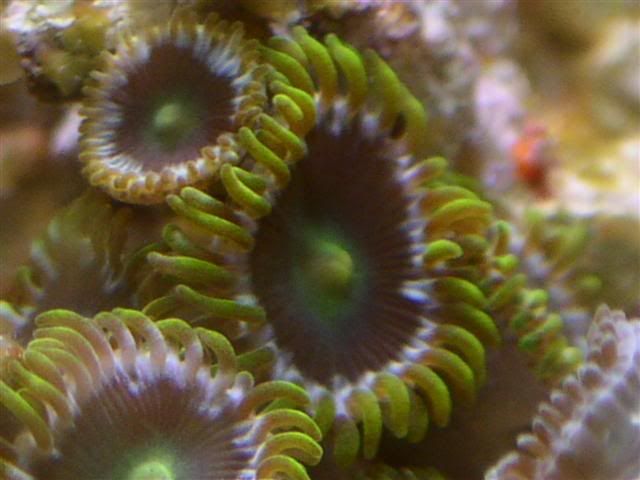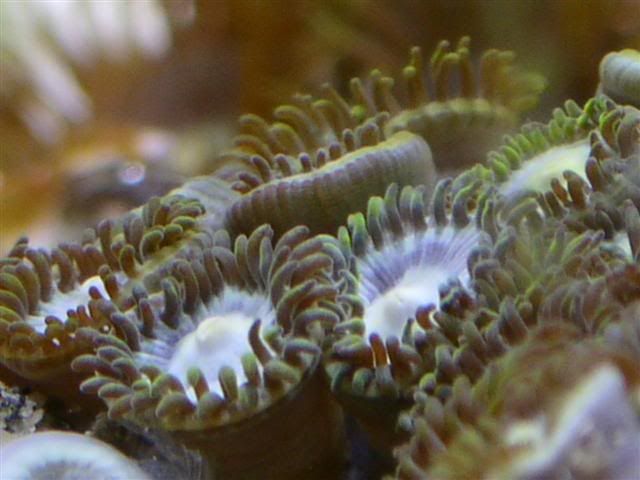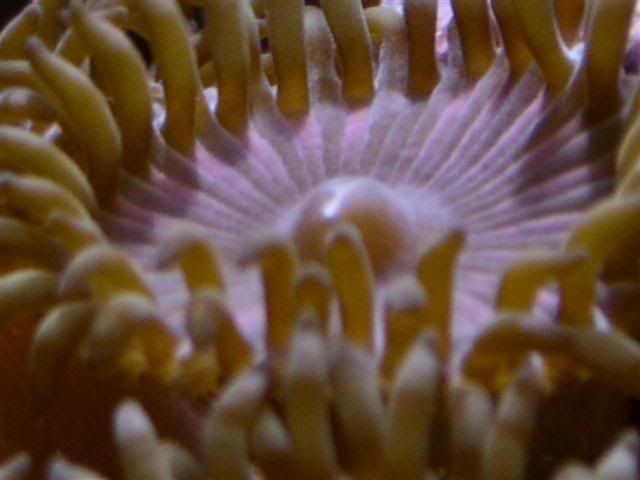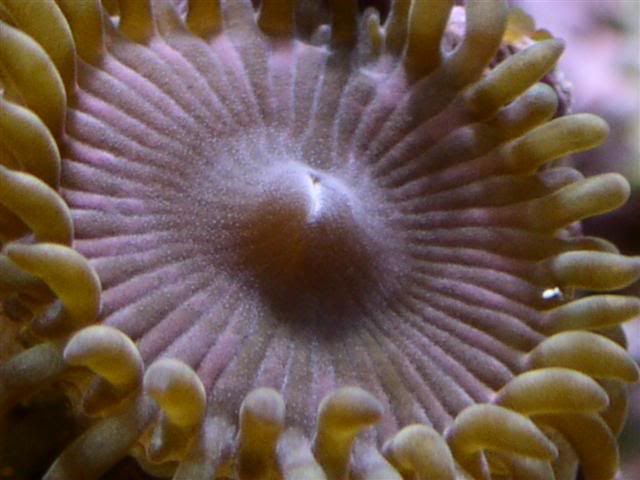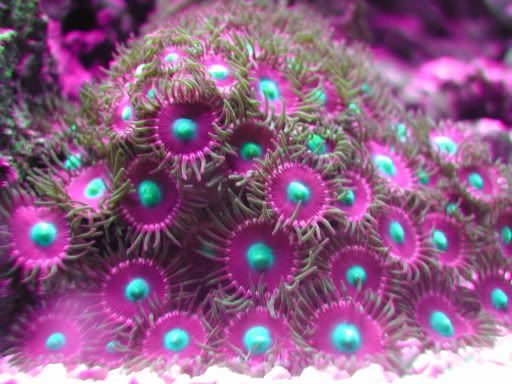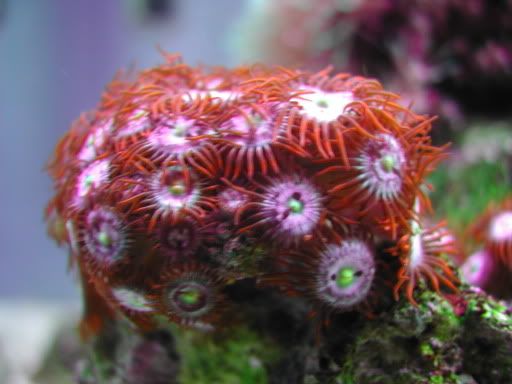nm reef
Active Member
(zoe-an'-thuss)
Commonly reffered to as "zooanthids"..."sea mats"..."button polyps"...these fast growing and hardy species are amoung the most color diverse corals I have seen availabe to hobbyists. In nature Zoanthus are very common and fast reproducing colonies that can be found throughout various reef zones. Zoanthus species are often very brightly colored and their oral disks and tentacles are likely to be seen in contrasting colorations.Often they can be found with several differently colored species occurring together. Experts indicate that in general Zoanthus are highly dependant on their zooxanthellae for energy and should be placed where they will recieve intense light. I seldom see the Zoanthus colonies I keep respond to direct feedings of meaty type foods but now and then there will be a response...experts claim that Zoanthus species do not exhibit feeding reponses to prey...but I think there may be exceptions depending on the food sources available.
It should be noted that there is potential with all Zoanthus species for a very serious problem. Most zoanthids produce a chemical called "palytoxin". This is a potent toxin and can be deadly.It is important to wear hand protection when handling these species especially if the handler has cuts or breaks in the skin. Many hobbyists routinely handle Zoanthus species without serious problems but due to reports of the toxic nature of the corals it may be wise to use care and take steps to prevent/avoid potential exposure.
In general I've found zoanthids to be readily available from local sources as well as assorted on-line retailers. The color diversity is simply put astounding. Numerous hobbyists can provide dramatic examples of the color diversity and it seems each day there is a new color morph available. I've found zoanthids to be extremely hardy and tolerant of assorted lighting sources...currents....but in general they seem to do best in moderate currents with intense lighting.
There are a few unwelcome pests that can pose problems to zoanthids...primarily a type of nudibranch that is reported to feast on them and a species of snail that seems to prefer them. I have removed several snails from my colonies and still find one now and then. Normally I'll visually inspect each new addition for pests before placement in my display and just to be safe I normally dip new additions in a iodine based dip for a few seconds to help control unwanted pests.
I don't consider myslf an expert on any coral species....certainly not Zoanthus ...much less any other specific species. But I have managed to aquire and so far successfully keep several colonies...below are recent shots of the assorted species I currently keep. Actually it'll be a 12 pac of recent photos highlighting the diversity in what I refer to as "Wizardry Reef"...it'll take a few posts to attach the pics so be patient and enjoy.
In closing....I'd like to encourage y'all to contribute to or if needed correct the information provided here...and by all means post pics of your own if you have them...and feel free to ask questions...I'm confident the members here can provide experience/information that can address any concerns/questions y'all might have.




Commonly reffered to as "zooanthids"..."sea mats"..."button polyps"...these fast growing and hardy species are amoung the most color diverse corals I have seen availabe to hobbyists. In nature Zoanthus are very common and fast reproducing colonies that can be found throughout various reef zones. Zoanthus species are often very brightly colored and their oral disks and tentacles are likely to be seen in contrasting colorations.Often they can be found with several differently colored species occurring together. Experts indicate that in general Zoanthus are highly dependant on their zooxanthellae for energy and should be placed where they will recieve intense light. I seldom see the Zoanthus colonies I keep respond to direct feedings of meaty type foods but now and then there will be a response...experts claim that Zoanthus species do not exhibit feeding reponses to prey...but I think there may be exceptions depending on the food sources available.
It should be noted that there is potential with all Zoanthus species for a very serious problem. Most zoanthids produce a chemical called "palytoxin". This is a potent toxin and can be deadly.It is important to wear hand protection when handling these species especially if the handler has cuts or breaks in the skin. Many hobbyists routinely handle Zoanthus species without serious problems but due to reports of the toxic nature of the corals it may be wise to use care and take steps to prevent/avoid potential exposure.
In general I've found zoanthids to be readily available from local sources as well as assorted on-line retailers. The color diversity is simply put astounding. Numerous hobbyists can provide dramatic examples of the color diversity and it seems each day there is a new color morph available. I've found zoanthids to be extremely hardy and tolerant of assorted lighting sources...currents....but in general they seem to do best in moderate currents with intense lighting.
There are a few unwelcome pests that can pose problems to zoanthids...primarily a type of nudibranch that is reported to feast on them and a species of snail that seems to prefer them. I have removed several snails from my colonies and still find one now and then. Normally I'll visually inspect each new addition for pests before placement in my display and just to be safe I normally dip new additions in a iodine based dip for a few seconds to help control unwanted pests.
I don't consider myslf an expert on any coral species....certainly not Zoanthus ...much less any other specific species. But I have managed to aquire and so far successfully keep several colonies...below are recent shots of the assorted species I currently keep. Actually it'll be a 12 pac of recent photos highlighting the diversity in what I refer to as "Wizardry Reef"...it'll take a few posts to attach the pics so be patient and enjoy.
In closing....I'd like to encourage y'all to contribute to or if needed correct the information provided here...and by all means post pics of your own if you have them...and feel free to ask questions...I'm confident the members here can provide experience/information that can address any concerns/questions y'all might have.








